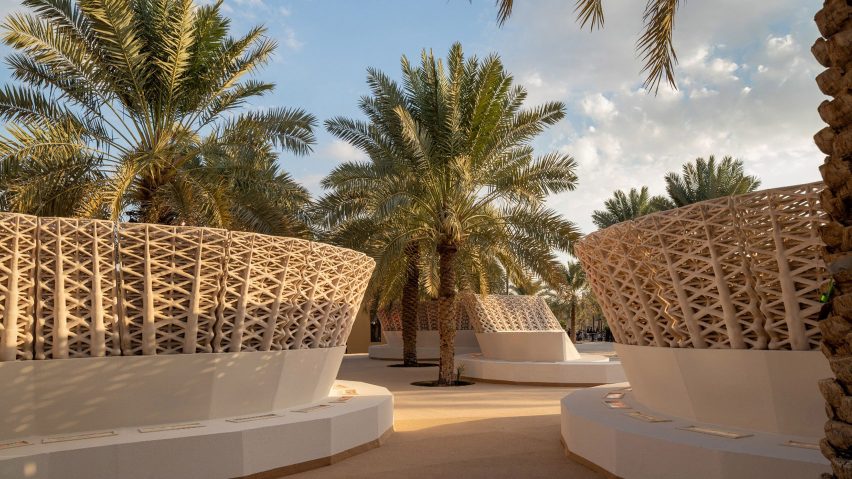Precht and Mamou-Mani Architects have completed a sustainable sand-printed installation called Sandwaves in Diryah, Saudi Arabia.
The ribbon-like structure is 3D printed from sand and furan resin for use as street furniture at Diryah Season – a sports and entertainment event in the Al-Turaif District.
Precht and Mamou-Mani Architects chose to build Sandwaves using sand as it is the most abundant natural material in the country, and it also responds to local building traditions.
The pair hopes it will demonstrate "the kind of innovation that is needed for our time" in the building industry, and how nature and technology can work harmoniously together.
"We both believe in the cradle-to-cradle approach to design, using materials that can go back to their natural state, leaving no trace," Arthur Mamou-Mani told Dezeen.
"Building in an ecological way also means to build with local materials," Chris Precht added.
"We asked ourselves what is the most common raw material around, so sand came naturally to our minds," Mamou-Mani continued.
Sandwaves comprises 58 individual 3D-printed elements that are combined to form the continuous ribbon, making it the "largest sand-printed installation to date".
Its undulating layout is intended to be immersive, evoking a series of narrow alleys and wide plazas for visitors to explore.
Meanwhile, the perforated aesthetic of the individual elements takes cues from the surrounding architecture, brise soleils – or sun-breakers, and palm trees.
This is designed to create "different shades of transparency" throughout the pavilion.
Precht and Mamou-Mani Architects developed the form of each individual element in collaboration with engineers at Format, who used parametric design tools to generate the optimum shape and thickness of each piece.
As sand is not a naturally strong material, this led to the pieces being thick and weighing approximately 160 kilograms.
"It is such a pleasure to work with a team who believes that technology can help the planet, who are willing to explore and experiment with new techniques and to inspire with new possibilities despite the big challenges," concluded Mamou-Mani.
3D-printed architecture is typically quick to build, low cost and resource efficient. In recent years, many designers and architects have used the technology to experiment with new materials and reimagine the potential for traditional ones.
Other examples of 3D-printed structures on Dezeen include the world's longest 3D-printed bridge in Shanghai and Yves Behar's proposal for the first 3D-printed community for low income workers in Latin America.
Photography is by Roberto Conte.
Project credits:
Studio Precht: Chris Precht, Fei Tang Precht, Andreas Stadlmayr, Zizhi You
Mamou-Mani Architects: Arthur Mamou-Mani, Ayham Kabbani, Nina Pestel, Sash Onufriev, Youen Perhirin
Designlab Experience: Mootassem Elbaba, Hibah Elbakree, Nausheen Baig
Fab.Pub: Giovanni Panico, Holly Hawkins
Format: James Solly, Sara Andreussi
Special thanks: PSU university students, Afan Sufak Manziel, SMI, Rely

